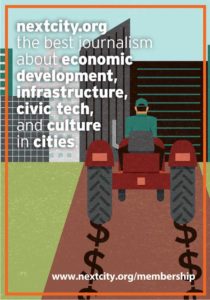By Jared Brey, Next City, April 9, 2019
A new law proposed in San Francisco could give nonprofit groups the first crack at buying multifamily buildings when they go up for sale, in an effort to preserve affordable housing in one of the most expensive cities in the country. [The law passed the Board of Supervisors unanimously on second reading, April 16, 2019.]
The proposal, called the Community Opportunity to Purchase Act (COPA), was sponsored by San Francisco Supervisor Sandra Lee Fewer after several years of research and advocacy by housing groups in the city. Under the law, which won a recommendation from the Planning Commission earlier this month, nonprofit groups would have a right of first refusal to buy buildings containing more than three units. If the law is passed, landlords who want to sell their buildings would first need to notify qualified nonprofit groups of their intent to sell. Nonprofits would have five days to express interest in making an offer and, if they do, another 25 days to work with tenants in the buildings and structure a deal. If the sellers then receive a higher offer from a private buyer, they would need to give nonprofits a chance to match the offer.
“We know that nonprofits often have trouble competing on the open market with speculative buyers whose plan is basically to buy the property, evict the tenants, and flip the building, or simply to re-rent them out at market rates …” says Ian Fregosi, a legislative aide to Supervisor Fewer. “By granting nonprofits the first opportunity to bid on these properties, this is going to have a big impact in giving them a fighting chance in buying more buildings and preserving more [units].”
“We have a really strong, progressive Board of Supervisors right now that’s really focused on preventing displacement and promoting affordable housing, as opposed to just purely building more market-rate housing,” Fregosi says.
Housing advocates have been working to get a law like COPA passed for at least the last four years, says Fernando Martí, co-director of the San Francisco Council of Community Housing Organizations. The law would build on other efforts like the Small Sites Program, which helps nonprofits find funding to purchase and preserve buildings with affordable units for low- and moderate-income tenants. That program has helped the Council’s member organizations acquire dozens of properties. But speculators are still able to move more quickly than nonprofits — or offer cash — leaving nonprofits at a competitive disadvantage even for the properties they’re best suited to buy, Martí says.
“We’ve had this pretty successful program — successful as long as there’s funding for it — but also there have been opportunities that we feel like we’ve missed, when a seller puts something out in the market and you end up with this bidding war,” he says.
Martí says the COPA proposal was informed by a similar law, called the Tenant Opportunity to Purchase Act, that’s been on the books in Washington, D.C., since 1980. There, tenants are given the right of first refusal to buy the buildings they live in when their landlords are looking to sell.
Throughout the last three decades, landlords and the real estate industry have found loopholes in the law and made several attempts to challenge or gut the D.C. statute, says Michael Diamond, a professor of law at Georgetown University Law Center. Diamond helped to write the TOPA legislation and spent many years running a legal clinic that helped tenants take advantage of it. He says that in the last few decades, he has found that it is easier to structure deals for larger projects, so that fixed costs can be spread across more units. It has also helped, when redeveloping properties for the low-income tenants who have already been living there, to add supportive services like daycare, after-school programs, and computer labs, Diamond says.
“Housing, while it’s critical to low-income people’s wellbeing, it’s not the only thing that’s critical,” he says.
In the last half-decade, Karoleen Feng, the director of community real estate at Mission Economic Development Agency (MEDA) in San Francisco, has helped the group acquire and maintain hundreds of apartments for low- and moderate-income people in the Mission. The Small Sites Program has been an important component of that work, Feng says. So has the San Francisco Housing Accelerator Fund, which helps finance affordable-housing deals. Seven of MEDA’s 22 building acquisitions in the last few years have been aided by the Accelerator Fund, Feng says.
Diamond, the Georgetown professor, says such funding is crucial. “There’s a huge need for subsidy,” he says. “Otherwise, the buildings will all gravitate to the higher end of the low-income spectrum, and the very low-income people won’t get housed.”

Landlords often have offers from buyers who will pay cash, more or less immediately. In one case, Feng says, her group lost a building on Mission Street because the owner, who also ran a business on the site, wanted the security of a cash offer.
“COPA is a policy and a legislative tool, and it has to be combined with a funding tool,” Feng says. “In San Francisco, we’ve currently developed a sizable fund, but we’re still looking for that permanent source of funds. So as we put COPA into place, we’re also going to be working with the city to find permanent funds to purchase [COPA-eligible] buildings.”
Despite the funding challenges, the program will give nonprofits and tenants an advantage they don’t have today. As Martí put it, a “pathway that allows us to get in front of the speculators who might be milling around.”
This article is part of Backyard, a newsletter exploring scalable solutions to make housing fairer, more affordable and more environmentally sustainable.
This article was originally published in Next City on April 9, 2019. Republished with permission.

Jared Brey is Next City’s housing correspondent. He is a former staff writer at Philadelphia magazine and PlanPhilly, and his work has appeared in Columbia Journalism Review, Landscape Architecture Magazine, U.S. News & World Report, Philadelphia Weekly, and other publications.

